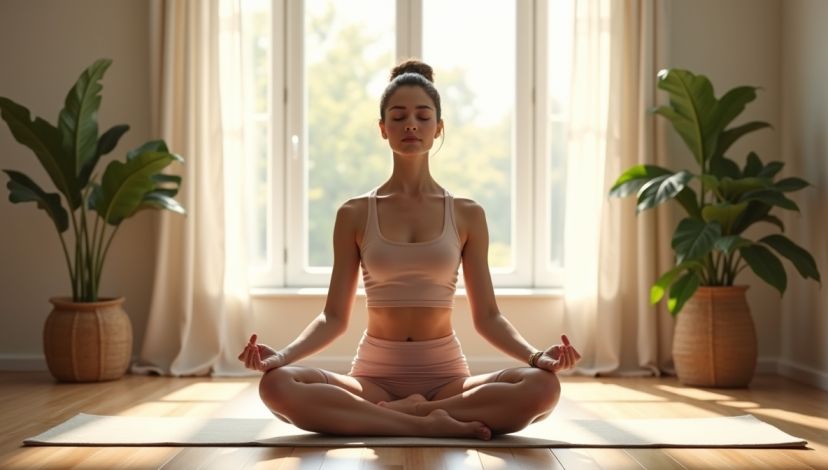In the busy lifestyle that we lead, we end up not relating to our bodies, and we have a persistent pain, stress, or feeling of tension without obvious remedies. The realization has led to the rising curiosity in activities that develop a relationship between mind and body. Somatic yoga is one of such practices that are being popularized. But what is somatic yoga, and why is it considered a transformative method for both physical and emotional wellbeing?
Somatic yoga combines traditional yoga asanas with somatic movement therapy, a subdued method with a focus on internal body sensations, attention, and self-perception. At first, unlike other popular styles of yoga, centering on proper postures or intense flows, somatic yoga encourages the participants to find a slow, meditative movement with a strong focus on understanding every detail of your sensations, the tensile feel of certain muscles, or the rhythm of your breathing on the inside of their bodies. This facilitates the experience of profound body embodiment, a close awareness, and being in one’s own body.
Such a technique does not just give one flexibility and relief of pain, but also liberates years of emotional tensions trapped in muscles and connective tissues. It helps to maintain the state of the nervous system, eliminate trauma, and restore habitual movement patterns experienced at the hands of stress or injury. Activating close connections with the body, this practice is useful for the novice yoga student and those who want to experience a more profound somatic journey to mental and physical well-being.
Key Takeaways:
- Somatic Yoga also builds your mind-body connection by using slow, mindful movements and body awareness.
- It Upholds Physical Healing and Emotional Release through retraining muscle memory and composing the nervous system.
- Available on all levels, it is a low-impact, trauma-sensitive intervention to strengthen wellbeing in the long term.
What Is Somatic Yoga and How Does It Work?
Somatic yoga, in essence, involves the development of profound or enhanced body self-awareness, and this is achieved through bodily inward focus, that is, concentrating on the body feelings rather than the appearance of the body or the stiffness of yoga poses. The goal is reached by emotional, exploratory motions, which are incorporated in the usual yoga poses, with the use of mindful breathing and relaxation methods.
As opposed to traditional yoga, during which the focus could be on body positioning or power, soma yoga will motivate you to understand the feeling associated with each action, experiencing muscle strain, spaciousness, breath patterns, and energetic changes. This sensory awareness helps to escape involuntary movement patterns/muscle habits, which lead to pain or restricted movement.
Somatic yoga draws upon several fields: the Feldenkrais Method and Continuum Movement, which focus on neuroplasticity of the brain, re-wiring the neuro-patterns to restructure itself in a functional way and relieve trauma. With the respect of the body charisma that the body bears, the practice fosters:
- Interoception: The sense of body sounds such as the heartbeat, breathing, or tight muscles.
- Proprioception: Body Positions and movements when in space.
- Exteroception: This refers to the external things that pose a stimulus on the body, like feeling or the heat.
Collectively, they improve the mind-body relationship and ensure even the nervous system reaction.
For instance, an example use-case:
Having post-traumatic back pain, Jessica believed in the strength of yoga but found that the classical one was too vigorous and involved. Somatic yoga allowed her to be back in contact on the signal of her body, to ease pain by incorporating slow and conscious movement in order to dissolve the emotional hold that manifested itself in physical rigidity.
Research of Somatic Yoga advantages: Physical, emotional, and neurological effects
Somatic yoga delivers a level of rejuvenating goodness on many levels based on centuries of knowledge and the new neuroscience.
| Benefit Type | Description | Expert Insight |
|---|---|---|
| Physical | Enhances flexibility, improves posture, and relieves chronic pain | Research suggests somatic movement helps decrease muscle tension and improve joint mobility |
| Emotional | Facilitates emotional release and trauma healing | Trauma-informed yoga specialists recognize somatic yoga’s trauma-sensitive approach as crucial to safe healing. |
| Nervous System Health | Activates the parasympathetic nervous system for relaxation | Neuroplasticity principles show the brain can rewire stress responses through mindful movement. |
Table 1 caption: The table includes the main advantages of somatic yoga, based on traditional knowledge and modern studies.
The softer path of somatic yoga decreases cortisol, the first leading stress hormone, to lower anxiety and enhance the quality of sleep. The practice instigates the formation of a relaxed state of the nervous system, so it is applicable in case of trauma recovery or chronic cases of stress.
Besides physical and emotional health, somatic yoga helps to develop a kind, non-judgmental attitude to your body, which leads to a healthier body image and strength.
A Clear Comparison On How Somatic Yoga Rolls Up Against Traditional Yoga:
Comprehending the difference between somatic yoga and the mainstream yoga approach will allow you to choose the most applicable one when pursuing wellness objectives. A side-by-side comparison is given in the table below:
| Feature | Traditional Yoga | Somatic Yoga |
|---|---|---|
| Focus | External alignment & pose mastery | Internal bodily sensations & awareness |
| Movement Pace | Often dynamic and flowing sequences | Slow, gentle, exploratory movements |
| Goal | Strength, flexibility, stress reduction | Healing, nervous system regulation, trauma release |
| Approach to Pain | Modify poses, but it can be effortful | Respect and follow the body’s limits consciously |
| Emotional Integration | Variable, often less emphasized | Core component, promotes emotional release |
| Suitability | Active practitioners, fitness-oriented | All levels, trauma-sensitive, therapeutic |
| Example Practice | Ashtanga, Vinyasa | Embodiment-focused mindful movement |
A comparison showing differences in quality and advantages of somatic yoga to a traditional yoga is presented in table 2.
Tip: Somatic yoga is trauma-sensitive with low injuries, and thus a great practice by individuals who have limitations or need emotional healing.
Learn How: Steps, Tips, and Scenario on How to Peacefully Practice Somatic Yoga
You can begin with somatic yoga, and it is not necessary to have a yoga mat or other equipment, just a space and desire to listen.
It is advised to start as follows:
- Get a Relaxing Place: Find a relaxed place that is comfortable.
- Put Intention: Concentrate on mindfulness and pleasant discovery, as opposed to accomplishment.
- Breath Awareness: The first part should be Breath Awareness, where you take a deep and conscious conscious breathing to center yourself.
- Participate in Micro-Movements: Try doing the tiny movements like calm movements of shoulders or hips, and focus on what is happening in your body.
- Introduce yourself to body scan: Whenever you are lying down, use your mind and your imagination, focus on the areas that are tight or loose.
- Practice in Basic Postures Movement Practicably: Experiment with conventional poses yet with an inner concentration on both the senses, adjusting into what is comfortable.
- Allowing Stillness: This is when you go to a relaxed position and pay attention to small sensations.
Example:
Mark was a sports injury patient given somatic yoga as a way to re-teach his movements. The unfrenzied and light-headed approach was useful in restoring his range of motion securely, decreased the fear of injury recurrence, and expedited the recovery. Mark highlighted the practice as having made him feel like learning his body anew, which is a very strong statement on the therapeutic aspects of somatic yoga.
More Internal Link: If you want to explore guided mindful movement further, you might also find our article How to Get Ozempic for Weight Loss: Easy Steps to Start helpful for your wellness journey.
The Future of Somatic Yoga: Research, Trends, and Wellness Incorporation
Somatic yoga is becoming known as a body-sensitized approach or an integrative path. This meshes with the trend toward trauma-informed care, neurorehabilitation, and holistic health.
Recent observations have shown that somatic practices favor neuro plasticity and emotional regulation, thereby becoming useful supplements in mental healthcare and treatment of chronic pains. Somatic yoga certifications are becoming widely aware of older wellness centers and yoga studio applications around the world due to increased market demanding modules and certification.
| Trend | Details |
|---|---|
| Integration with Therapy | Practices combined with psychotherapy for trauma recovery |
| Digital Accessibility | Online classes and apps are making somatic yoga widely available |
| Research Expansion | More clinical trials examining somatic yoga efficacy |
| Workplace Wellness | Employee programs incorporating somatic breaks for stress |
| Personalized Practice | Tailored sessions focusing on individual needs |
Table 3 title: Major trends that will define further growth and adoption of somatic yoga.
Remember: Evidence increasingly supports somatic yoga in the scientific community and the mainstream. Google’s EEAT SEO principles highlight its credibility. These principles showcase somatic yoga’s depth and skill in mind-body therapy. More people recognize its value and effectiveness every day.
To find more elaborate research finding, go to the National Center of Complementary and Integrative Health (NCCIH) site or check out our article 6-Week Plan: Ozempic Weight Loss Results & What to Expect.
Conclusion
Understanding what is somatic yoga reveals a practice that goes far beyond physical exercise — it is a journey into self-awareness, healing, and emotional freedom. Somatic yoga will help you remerge, unload, and balance by giving priority to the soft movement, sensory awareness, and kindness to yourself.
Whether you manage chronic pain, feel emotional stress, or seek body awareness, choose somatic yoga as a safe, effective option. Rely on its evidence-informed approach to support your well-being. Use this practice to build presence, strength, and joy through mindful movement. Let your body guide you toward deeper awareness and lasting comfort.
Start by finding a local or online somatic yoga class that fits your schedule. Begin a simple home practice with breathwork and gentle movement. Build consistency by practicing regularly, even if just for a few minutes. Connect directly with your body and mind through focused, intentional movement. Experience the full benefits this transformative practice offers when you stay engaged.
FAQs
Q1: How does somatic yoga differ with regular yoga?
A: This practice focuses on feelings of the body in the inside, but not in shapes and forms on the outside.
Q2: Can someone who is new to this practice or has injuries do somatic yoga?
A: Yes, this practice is available to all bodies, and to hard-to-heal or injured ones it is most helpful as it is trauma-sensitive in nature and is slow.
Q3: How many times in a week should I practice this yoga to yield the best results?
A: Helping you connect your mind to your body, eliminate tension, and make you feel better emotionally, 2-3 times weekly will suffice.
Q4: Is there a possibility that this practice can help to reduce stress and anxiety?
A: Yes, it stimulates the parasympathetic part of the nervous system and promotes relaxing and lowers the stress hormone, and relax the mind.
Q5: Is some special equipment or experience necessary to start?
A: You don’t need any special equipment to start. The practice welcomes newcomers with non-intimidating exercises focused on sensation and breath.




